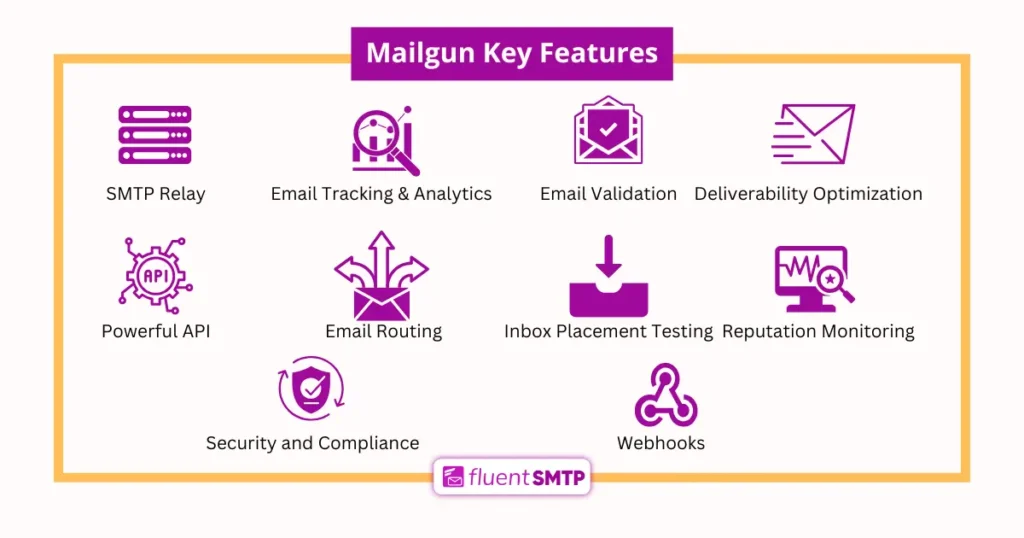
Mailgun Review: Is It the Best Transactional Email Delivery Service for Your Business?
Mailgun is an email delivery service designed to make businesses’ lives easier, especially when you are sending bulk emails. It’s built for developers which offers useful tools that quickly handle high-volume emails and increase engagement.
But, it’s not perfect without its drawbacks. Do you know how?
Mailgun has some lacking on some basic features like built-in email templates or a user-friendly interface for non-developers. So, if you’re uncomfortable with coding or technical setup, getting started with Mailgun can be tough.
So, is Mailgun worth it for your business? Well, that depends.
In this hands-on Mailgun review, we’ll explain everything you need to know about Mailgun, its key features, pricing, pros and cons, and more. Whether you’re a developer or a marketer looking for a reliable tool or a business trying to send emails without the hassle, we’ll help you decide if Mailgun is the right choice for you.
Let’s dive in.
Mailgun Overview
Mailgun was founded in 2010 by Ev Kontsevoy and Taylor Wakefield with the simple goal of making email delivery easy and reliable for businesses. Initially part of Y Combinator’s 2011 class, Mailgun quickly made its mark in the email space.
After being acquired by Rackspace in 2012, Mailgun became independent in 2017, then it was acquired by Thoma Bravo in 2019. Finally, Mailgun was bought by Sinch for around $2 billion in 2021.

Today, Mailgun powers over 150,000 companies including tech giants like Microsoft, Wikipedia, American Express, and NHL to send transactional and promotional emails that actually land in inboxes. That’s why, they are known for its reliability, scalability, and ability to handle high-volume email sending.
Also, do you know the best thing about Mailgun? It can easily integrate with WordPress. You just have to install the Mailgun plugin on your WordPress site and send your transactional email directly from your website.
While competitors like SendGrid, Postmark, and Amazon SES offer similar services, Mailgun’s focus on deliverability and its easy integration makes it especially popular with businesses which looking for a solution that’s both strong and flexible.
What is Mailgun?
Mailgun is an email service that is specially built for developers to send, receive, and track emails. It offers powerful tools to manage mass amount emails and improve engagement.
With its easy-to-use API(Application Programming Interface) and SMTP(Simple Mail Transfer Protocol) service, You can quickly send transactional emails, marketing campaigns and notifications. Also, Mailgun simplifies email management and provides features to track and optimize email performance.
What is Mailgun Used for?
Mailgun is an email delivery platform that lets you send and track your emails and optimize your email marketing, as described below:
- Sending Emails: Seamless email integrations with your systems ensure speed, high reliability, and compliance with your industry standards using Mailgun.
- Optimizing Emails: Mailgun provides tools that will help you to improve email engagement, avoid spam filters, and increase the return on investment, thus making sure that your emails are opened and acted upon.
- Email Validation: You can keep your email lists clean and lean with high-speed email validation from Mailgun, reducing bounce rates and increasing deliverability while maintaining smooth campaigning.
- Automation of Email Marketing: It is equipped with workflows and analytics, which enables the effective automation of email at scale, optimizing campaigns for better performance using data-driven decisions.
- Blocking Spam Signups: Mailgun ensures that email addresses are genuine, blocking out fake signups and hence saving your time and resources for real users.
- Improved Deliverability: You can get more emails in the inbox with expert guidance from Mailgun toward better engagement and higher conversions.
Mailgun Pricing and Plans
So, you already know the benefits of using Mailgun. But another important factor to consider when choosing Mailgun is its pricing. There are two pricing plans offered by Mailgun – Mailgun Send Pricing and Mailgun Optimize Pricing. You can choose the one that best suits your needs and start using it without any hassle.
Here’s a table summarizing Mailgun’s send pricing plans:
| Plan | Cost | Emails Included | Key Features |
|---|---|---|---|
| Free | $0/month | 100 emails/day | Ticket support, RESTful email APIs, 1 custom sending domain, tracking, analytics |
| Basic | Starting at $15/month | 10,000 emails/month | No daily limits, monthly overage options, 1 custom sending domain, 1 API key |
| Foundation | $35/month (after 1 month free) | 50,000 emails/month | Email template builder, 1,000 custom sending domains, 5 days log retention |
| Scale | $90/month (after 1 month free) | 100,000 emails/month | SAML SSO, dedicated IP pools, send time optimization, live phone & chat support |
Also Here’s another table that summarizes Mailgun’s Optimize pricing plans:
| Plan | Cost | Key Features |
|---|---|---|
| Starter | Free for 1 month, then $49/month | 2,500 email address validations, 25 inbox placement tests, 500 email previews, ticket support, detailed documentation, overages from $0.10/email preview, $0.75/inbox placement test, $1.20/100 validations |
| Pilot | Free for 1 month, then $99/month | 5,000 email address validations, 50 inbox placement tests, 1,000 email previews, spam trap monitoring (1 domain), blocklist monitoring (1 IP, 1 domain),overages from $0.10/email preview, $0.75/inbox placement test, $0.80/100 validations |
| Contract | Custom pricing | Unlimited users, custom email address validations, custom inbox placement tests, custom email previews, designated Technical Account Manager, custom monitoring for domains and IP addresses |
Mailgun Key Features and Benefits
As mentioned earlier, Mailgun offers a variety of features and benefits. You can take full advantage of these features based on your specific needs. However, some key features are particularly worth discussing with you. So don’t waste time, let’s dive into these features.

SMTP Relay
- Seamless Email Sending: Mailgun’s SMTP relay allows you to send emails directly through your existing applications, without requiring custom coding.
- Authentication Support: Ensures secure email sending with SMTP authentication protocols, including TLS encryption for added security.
- High Deliverability: Optimized to handle transactional and bulk email delivery with minimal latency.
- Customizable Sender Domains: Send emails from custom domains with proper authentication (SPF, DKIM, and DMARC) to build trust and improve inbox placement.
Email Tracking and Analytics
- Comprehensive Insights: Mailgun tracks your email deliveries, opens, clicks, bounces, and other engagement metrics to optimize your email performance.
- Performance Optimization: It uses this data to refine your email campaigns, improve targeting, and increase overall effectiveness.
Email Validation
- Real-Time Email Validation API: It can identify and filter out invalid email addresses at the capture point which reduces the bounce rates and maintains a healthy sender reputation.
Deliverability Optimization
- Inbox Placement Tools: You can use tools designed to boost the likelihood of your emails reaching the inbox instead of the spam folder.
- Better Connection: Improve the connection with recipients and enhance the reach of your email campaigns perfectly.
Powerful API for Developers
- Seamless Integration: Mailgun’s RESTful APIs make it easy to integrate email functions with your applications across various programming languages.
- Customization Options: Developers can design email functionalities to fit specific business needs, creating a more personalized user experience.
Inbound Email Routing
- Parse Incoming Emails: It can extract meaningful data from received emails, such as attachments, sender information, and message content.
- Two-Way Communication: Create interactive email workflows, like customer support ticketing or email-based approvals.
- Custom Rules: Define custom routing rules to process incoming emails based on specific conditions.
Inbox Placement Testing
- Proactively test email placement: Determine if your emails will end up in the inbox, spam folder, or other tabs across major mailbox providers.
- Identify and fix deliverability issues: Get insights into why emails might be landing in spam, such as issues with subject lines or email authentication (SPF, DKIM, DMARC).
Reputation Monitoring
- Real-time updates: Track and optimize your email reputation based on domain and IP address.
- Proactive management: Monitor your email deliverability and receive alerts if issues arise, such as being added to a blacklist.
- Customized strategies: Develop tailored plans to manage IP reputation and domain reputation, ensuring your emails reach the intended recipients.
Security and Compliance
- Suppression Management: Mailgun automatically handles bounced, unsubscribed, or spam-complained emails which maintain a clean email list.
- Regulatory Compliance: It ensures your email practices align with industry regulations to maintain compliance and avoid penalties. It also maintains HIPAA, SOC I & II, and GDPR compliance.
Webhooks
- Real-Time Event Notifications: You can set up Webhooks to receive instant updates on email events like delivery, opens, clicks, and bounces.
- Custom Integrations: Also, you can use webhooks to integrate email activity data with your CRM, analytics, or custom applications.
These features make Mailgun a comprehensive solution for your businesses and developers seeking reliable and scalable email services.
Mailgun Pros and Cons
Mailgun offers a range of features that make it a popular choice for developers and businesses looking for an email delivery service. However, like any tool, it comes with both benefits and potential drawbacks that you should consider before integrating it into your system.
Pros
Cons
Overall User Experience and Customer’s Mailgun Review
Mailgun’s overall user review is 4.2 out of 5 in G2 and 4.3 out of 5 in GetApp
So far, we’ve shared our personal experience with Mailgun. However, as Mailgun is widely used across different industries and for various purposes, it’s valuable to consider feedback from other users to understand its broader impact.
Here are a few reviews from real users who have benefited from Mailgun:
You can see a review here in G2, Armstrong N., an IT Support Associate at a non-profit organization, finds Mailgun for its reliable email delivery, user-friendly APIs, and detailed analytics.

While acknowledging Mailgun’s strengths, he suggests that the pricing model could be more cost-effective for high-volume users and that certain advanced features might require a higher-tier subscription.
Let’s go on another review of Pablo C., a Professor of Online Marketing and Communication, who finds Mailgun to be a useful platform for sending bulk emails. He recommends Mailgun for its ease of use and integration with WordPress for e-commerce. However, he suggests that the pricing model could be more flexible.

Another review of different purposes, Martin B. is highly satisfied with Mailgun as an SMTP and email API. He praises its affordable pricing, ease of use, and impressive deliverability rates, which exceeded his expectations.

However, he mentions that the user and account management interfaces can be challenging to navigate and configure.
By considering these three different perspectives, it’s clear that Mailgun is a reliable and efficient choice for both technical and non-technical users. Its strengths include high deliverability, API integration, and bulk email capabilities. However, as noted by several users, pricing adjustments and improved management features could make Mailgun an even better solution for email delivery needs.
How to Setup Mailgun for WordPress Email Sending
So, if you are a WordPress user and running an e-commerce website, it’s very important to send transactional emails from your website to your customers. But in most cases, users find that their WordPress emails are going to spam.
WordPress has a default function called wp_mail() that uses the PHP Mailer open-source library for all email communication. The problem is that many web hosting providers are not configured with the wp_mail() function, or even worse, sometimes they block it.
As a result, your email are going to the spam folder or never delivered. But there is a solution! Use an SMTP plugin with your website, which uses Simple Mail Transfer Protocol which overwrites the default PHP mail function and delivers your email successfully.
And, for the best result, we recommend you use the FluentSMTP plugin in your WordPress site. It’s a free WordPress plugin which designed to integrate with popular email services like Mailgun with your website.
FluentSMTP also offers some valuable features like:
- Email Failure Alerts: Receive notifications via email, Telegram, Discord, or Slack
- Smart Routing: Manage multiple connections efficiently
- Email Log: Track your email activity effortlessly
And setting up Mailgun with WordPress is very easy for any tech or non-tech person. You just need to install and activate the FluentSMTP plugin, get the Mailgun API key, and simply integrate with your website and enjoy the Mailgun services.
But don’t worry. We have clear documentation on configuring Mailgun with your WordPress site to clarify any confusion.
FluentSMTP+Mailgun=
Perfect Email Delivery!
(100% Free)
Integrate Mailgun with FluentSMTP and send your transactional marketing email smoothly

Mailgun Alternatives
We have shown you everything about Mailgun from every perspective. But if you find Mailgun unsuitable for your business, you can consider some alternatives.
Here are some good alternatives for you to compare among them.
- SendGrid: SendGrid is a powerful API in relation to emails, with advanced functionalities. It has a simple-to-use interface and great versatility, whether for transactional or marketing emails. Also, you can check an in-depth comparison between SendGrid vs. Mailgun.
- Postmark: While picking transactional emails, Postmark is the popular choice over the deliverability and performance of emails. It’s a pretty reliable and easy-to-use service.
- Mailtrap Transactional SMTP Service: if you’re looking for a developer-friendly SMTP service that combines email testing and production email sending, Mailtrap is an excellent alternative. It provides detailed logs, deliverability insights, and a secure sandbox environment to help you test and optimize your transactional emails before they go live.
- Mailchimp Transactional (formerly Mandrill): Mailchimp Transactional is designed to send personalized, event-driven emails with high deliverability.
Final Verdict: Should You Choose Mailgun?
So, in the overall review of Mailgun, we must say, that Mailgun is an excellent choice if you’re a developer or a business that values performance, scalability, and detailed analytics for email delivery. Its API-first approach and robust tools make it a top-tier solution for high-volume transactional and marketing emails.
And for WordPress users, combining Mailgun with FluentSMTP simplifies the integration process, ensuring reliable email delivery and providing helpful features like email logs and failure alerts—all for free. This pairing is ideal for businesses aiming to enhance their email workflows without technical headaches.
However, if you’re not comfortable with technical setups or need a more beginner-friendly platform with built-in templates, Mailgun might not be the best fit. Similarly, businesses on a tight budget should carefully consider the potential costs of advanced features.
If deliverability, reliability, and scalability are your top priorities, Mailgun is a strong contender for you, especially when paired with FluentSMTP for WordPress. But for simpler needs, exploring alternatives like SendGrid or Postmark may be the better choice.
FAQs

Ratul Ripon
I enjoy turning complex ideas into simple ones and engage with people through my writing. With a background in Oceanography, I create technical content that’s both easy to understand and interesting.
Table of Content
Subscribe To Get
WordPress Guides, Tips, and Tutorials












Leave a Reply